All of you, I’m sure, have washed your boat many times and may well have some of your own tips and tricks to share, but John, Capt. Anthony, and I (Bob) thought we’d share our the strategies we’ve developed over the years.
First, our “tools” of choice. 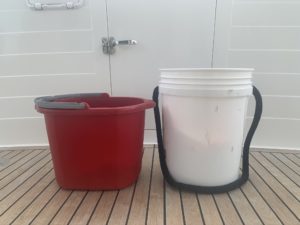
- John and I prefer a sturdy rectangular shaped on that fits brushes well (vs. round). The Captain’s favorite is a 5-gallon “paint bucket” style with rope handles.
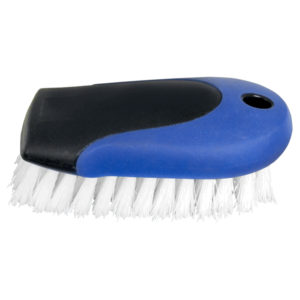
- Brushes – we like all three. Stiff for the decks (including, occasionally, the teak) when they really need a good cleaning, medium for normal, everyday deck work, and soft for smooth gelcoat and paint. Also, a stiff hand brush (at right) for scrubbing teak decks and spot cleaning on the non-skid.
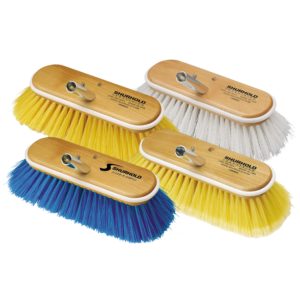
- We always have at least one stick chamois or mop, pictured below to the right, plus an Aborber or two or three, pictured below to the left. If you don’t have an Absorber, get one! I thought everybody had ‘em but recently discovered that’s not the case. They’re great for drying not only everything outside, they also come in handy inside the boat for drying showers, bilges, sinks, you name it. And they’re super tough. You really can’t wear them out.
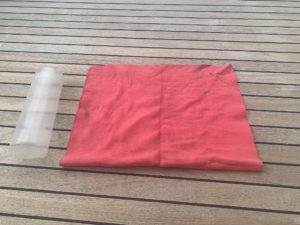
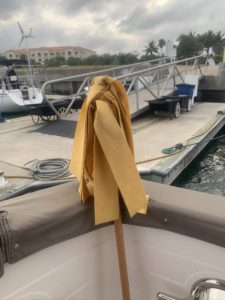
- Blade squeegee. If you want to keep your windows looking good, squeegee them off as you go, especially in the sun. Absorber’s work quite well for this too. Drying the windows quickly after washing, will help prevent those pesky water spots on the glass.
- Cleaners/waxes. We like Metal Wax for the rails, Awlcare wax for the hullsides (recommended by Awlgrip, which all 52’s have), Orpine boat soap, and Teak Deck Systems for cleaning your teak. More on that later. We usually have a host of other specialty cleaners on board.
Maybe the most important piece of all this is the need to thoroughly hose down after most every outing (unless you’re fortunate enough to be in fresh water). You don’t need to get brushes out (although that’s not a bad idea), but at minimum, get as much salt off as you can. Here are some specific areas NOT to miss (some general, but many unique to a Krogen Express):
- The “lip” just under the main rubrail. This falls in the category of sort of out of sight, out of mind, but salt accumulates there and since you can’t easily see it, it tends to get overlooked. On the dock side, we always spray it off well and then run our hand along to make sure it’s salt free.
- Both pilothouse doors. Be sure to spray them down well and then train a hard stream right into the cracks. Concentrate on any area where there’s hardware – handles, hinges, latches. Beware – you might want to dog them first!
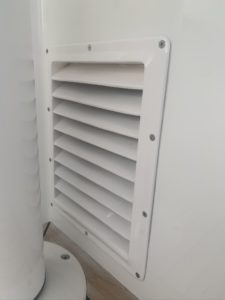
- All engine room and bilge vents. These are aluminum and subject to corrosion. You’ll delay the inevitable repaint with regular attention after running your boat. The side vents are the most susceptible, but don’t ignore the two in the cockpit.
- Everything metal. Get the bow and side rails well (run your hands along them as you spray them off), rub rails (don’t miss the ones on the lower rail and swim platform), the stanchions in the cockpit, the boat deck rails, bimini frame, windscreen brackets, antennae brackets, hatches, portlights, crane, and air horn. And, with some regularity, your mast.
- Your brightwork. Leaving a coat of salt on your brightwork will definitely shorten the time between necessary re-applications and, if it
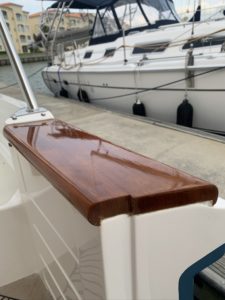 works into the joints, will cause bigger problems.
works into the joints, will cause bigger problems. - Windshield wipers and the bill above them. These are two areas easily missed.
- OK. Now we’ve done the whole boat. I know. But leaving the gelcoat salty will
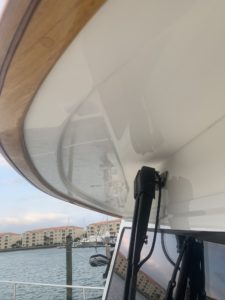 shorten it’s “bright and shiny” life. Do your best to get the salt off. You won’t regret it.
shorten it’s “bright and shiny” life. Do your best to get the salt off. You won’t regret it.
Now for washing suggestions (in no particular order).
- Good idea to start up top and work your way down. I know this is obvious, but …
- When cleaning the foredeck, hard spray down into the anchor hatch seam, especially around the hinges, to clean the accumulated the
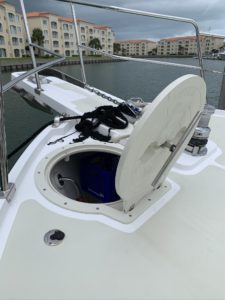 junk out of there. Then lift the handle and clean the pull cups and handle channel. Finally, when you’re done up there, open the hatch and let the cups drain.
junk out of there. Then lift the handle and clean the pull cups and handle channel. Finally, when you’re done up there, open the hatch and let the cups drain. - Don’t miss the bill of the pilothouse. This is another spot easily missed.
- If the wax on your house sides, toe rails, and hull sides is relatively new, avoid using soap on them because it will tend to cut the wax. If you have to attack a particularly messy spot with some cleaner, consider a cleaner wax to replace what came off. Also avoid brushes, except maybe the softest ones, so you don’t take wax off. Instead, use a sponge or wash mitt to wipe those areas down.
- Similarly, a wash mitt works best on the metal. OK to use some soap there. And be sure to use your Absorber to dry the metal when you’re done washing.
- Give your portlights a little attention by hand. They’re also easy to overlook. Use your mitt to get the dirt/salt off and then dry them with your absorber to make them shiny!
- Open your boarding gates, both sides and in the transom, and clean the sills as well as the sides. Don’t miss the KE name plates while you’re at it.
- Also open each of the doors (pilothouse both sides and salon) and clean the thresholds, even if just at the end with your absorber.
- If not every time you wash, don’t miss the cockpit overhead, especially the outboard aft corners, which certainly tend to get salty on a regular basis.
- Clean under your dinghy with some regularity and try to hit the aft deckboat bill most every time you wash, pictured below to the right. This requires walking on
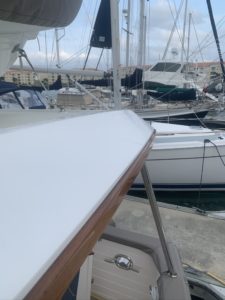 the caprail all the way around, of course.
the caprail all the way around, of course. - Don’t miss washing your crane, also easily overlooked, and your mast, at least periodically.
- Don’t use anything stronger than boat soap on your flybridge windscreen and dry it with your Absorber once cleaned and rinsed.
- Light soap is ok on your brightwork, but rinse thoroughly and again, dry with your Absorber.
- Scrub your teak decks, across the grain, with a medium or stiff brush a couple times a month, to keep it brown. Every couple months, you’ll need to use the stiff hand brush, get down on your knees, and scrub your decks by hand, following the directions on your cleaner. This is a balance between too much and too little. Too little and they’ll get grey with some black from mildew. To often, particularly with brushing with the grain, and you’ll take the deck down.
- Use your mop to dry the side decks, hatches, topsides, and hullsides. The Aborber works great everywhere else. Give special attention to your swim platform and transom, since those are usually the first things everyone sees.
- Rinse, or wipe down all hatch and lazarette gutters and drains. After washing, dirt and debris tends to collect in these areas.
